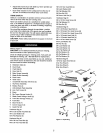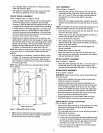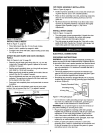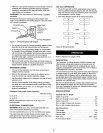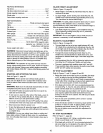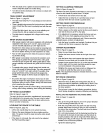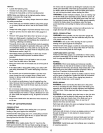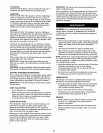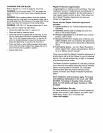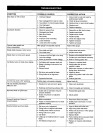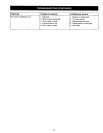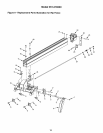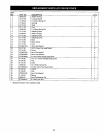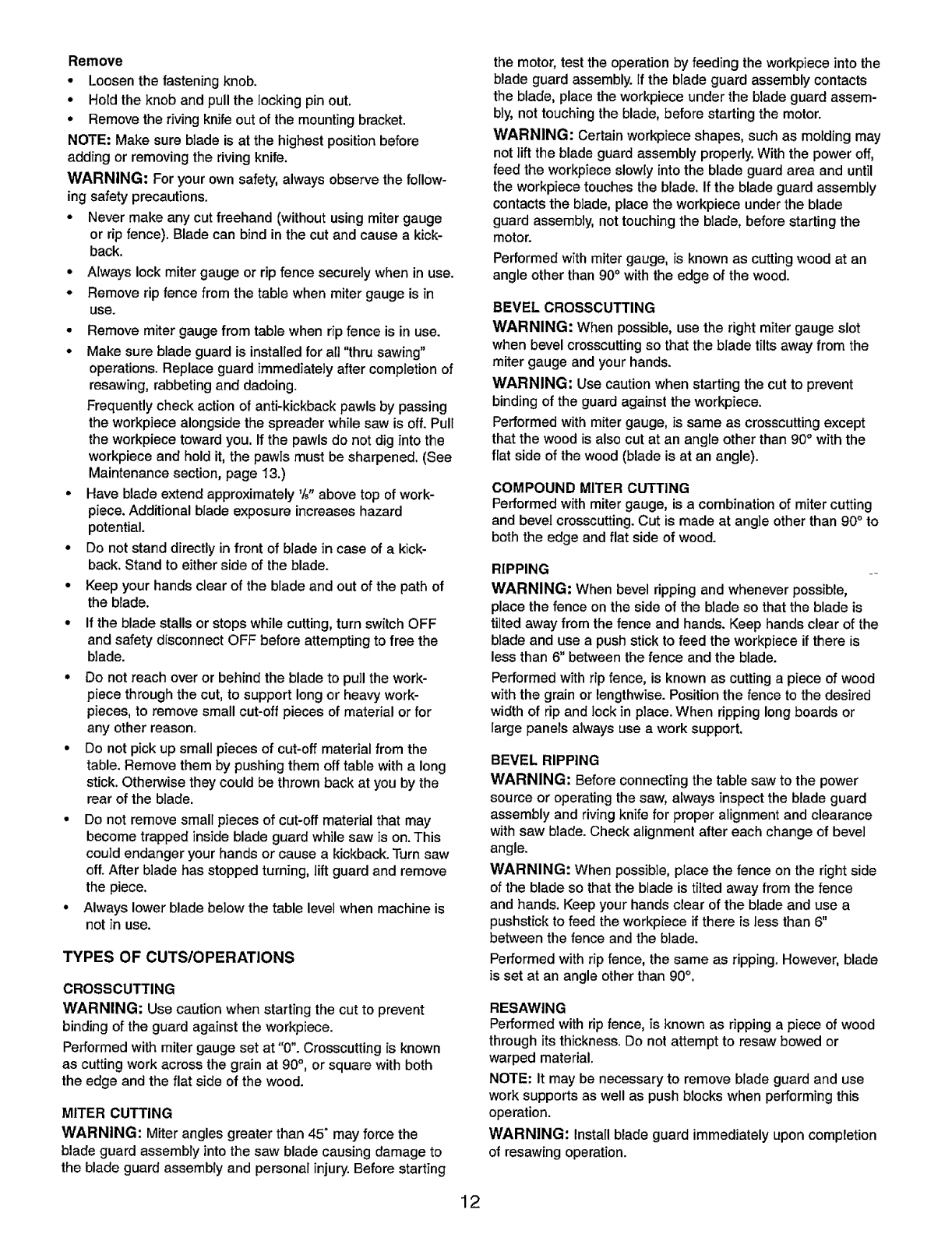
Remove
• Loosen the fastening knob.
° Hold the knob and pull the locking pin out.
° Remove the riving knifeout of the mounting bracket.
NOTE: Make sure blade isat the highest position before
adding or removing the riving knife.
WARNING: For your own safety, always observe the follow-
ing safety precautions.
° Never make any cut freehand (without using miter gauge
or rip fence). Blade can bind in the cut and cause a kick-
back.
° Always lock miter gauge or rip fence securely when in use.
• Remove rip fence from the table when miter gauge is in
use.
° Remove miter gauge from table when rip fence is in use.
° Make sure blade guard is installed for alt "thru sawing"
operations. Replace guard immediately after completion of
resawing, rabbeting and dadoing.
Frequently check action of anti-kickback pawls by passing
the workpiece alongside the spreader while saw is off. Pull
the workpiece toward you. If the pawls do not dig into the
workpiece and hold it, the pawls must be sharpened. (See
Maintenance section, page 13.)
° Have blade extend approximately '/8"above top of work-
piece. Additional blade exposure increases hazard
potential.
° Do not stand directly in front of blade in case of a kick-
back. Stand to either side of the blade.
• Keep your hands clear of the blade and out of the path of
the blade.
• if the blade stalls or stops while cutting, turn switch OFF
and safety disconnect OFF before attempting to free the
blade.
• Do not reach over or behind the blade to pull the work-
piece through the cut, to support long or heavy work-
pieces, to remove small cut-off pieces of material or for
any other reason.
• Do not pick up small pieces of cut-off material from the
table. Remove them by pushing them off table with a long
stick. Otherwise they could be thrown back at you by the
rear of the blade.
• Do not remove small pieces of cut-off material that may
become trapped inside blade guard while saw is on. This
could endanger your hands or cause a kickback. "liJrn saw
off. After blade has stopped turning, lift guard and remove
the piece.
° Always lower blade below the table level when machine is
not in use.
TYPES OF CUTS/OPERATIONS
CROSSCUTTING
WARNING; Use caution when starting the cut to prevent
binding of the guard against the workpiece.
Performed with miter gauge set at "0". Crosscutting is known
as cutting work across the grain at 90°, or square with both
the edge and the flat side of the wood.
MITER CUTTING
WARNING: Miter angles greater than 45" may force the
blade guard assemblyintothe saw bladecausingdamage to
the blade guardassemblyand personalinjury. Before starting
the motor, test the operation by feeding the workpiece into the
blade guard assembly. If the blade guard assembly contacts
the blade, place the workpiece under the blade guard assem-
bly, not touching the blade, before starting the motor.
WARNING: Certain workpiece shapes, such as molding may
not lift the blade guard assembly properly. With the power off,
feed the workpiece slowly into the blade guard area and until
the workpiece touches the brade. If the blade guard assembly
contacts the blade, place the workpiece under the blade
guard assembly, not touching the blade, before starting the
motor.
Performed with miter gauge, is known as cutting wood at an
angle other than 90° with the edge of the wood.
BEVEL CROSSCUTTING
WARNING: When possible, use the right miter gauge slot
whenbevel crosscuttingso that the blade tiltsaway from the
miter gaugeandyourhands.
WARNING: Usecautionwhenstartingthe cutto prevent
binding ofthe guard againstthe workpiece.
Performedwithmitergauge, is same as crosscuttingexcept
that thewood is alsocutat an angle otherthan90° withthe
flat side ofthe wood(blade is at an angle).
COMPOUND MITER CUTTING
Performed with miter gauge, is a combination of miter cutting
andbevelcrosscutting.Cut is made at angle otherthan 90° to
both the edge andflat side ofwood.
RIPPING
WARNING: When bevel ripping and whenever possible,
place the fence on the side of the blade so that the blade is
tilted away from the fence and hands. Keep hands clear of the
blade and use a push stick to feed the workpiece if there is
less than 6" between the fence and the blade.
Performed with rip fence, is known as cutting a piece of wood
with the grain or lengthwise. Position the fence to the desired
width of rip and lock in place. When ripping long boards or
large panels always use a work support.
BEVEL RIPPING
WARNING: Before connecting the table saw to the power
source or operating the saw, always inspect the blade guard
assembly and riving knife for proper alignment and clearance
with saw blade. Check alignment after each change of bevel
angle.
WARNING: When possible, place the fence on the right side
of the blade so that the blade is tilted away from the fence
and hands. Keep your hands clear of the blade and use a
pushstick to feed the workpiece if there is less than 6"
between the fence and the blade.
Performed with rip fence, the same as ripping. However, blade
is set at an angle other than 90°.
RESAWlNG
Performed with rip fence, is known as ripping a piece of wood
through its thickness. Do not attempt to resaw bowed or
warped material.
NOTE: It may be necessary to remove blade guard and use
work supports as well as push blocks when performing this
operation.
WARNING: Install blade guard immediately upon completion
of resawing operation.
12




